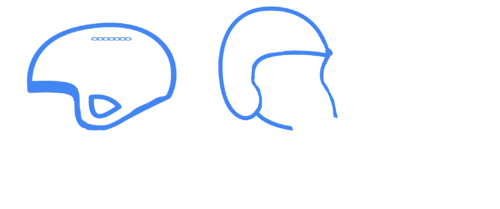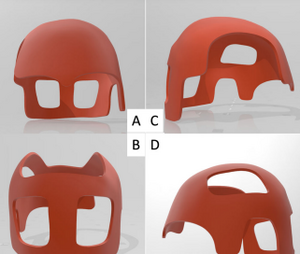Helmet for Post-Craniectomy
Original Editor - Syeda Bushra Zehra Zaidi
Top Contributors - Syeda Bushra Zehra Zaidi, Vidya Acharya, Lucinda hampton and Carina Therese Magtibay
Helmet For Post-Craniectomy[edit | edit source]
Protective helmets are commonly prescribed to patients who have undergone Decompressive craniectomy (DC) to prevent injury to the craniectomy site during the postoperative period.
After craniectomy, patients are generally advised to wear a helmet when mobilizing to protect the unshielded brain from damage. However, there exists limited guidance regarding head protection for patients at rest and when being transferred or turned to avoid injury to the unprotected brain.[1]
Types Of Helmets[edit | edit source]
Choosing the appropriate helmet for post-craniectomy patients should be done in consultation with healthcare professionals such as neurosurgeons or rehabilitation specialists. They will consider various factors, including the location and extent of the craniectomy, the patient's overall health, and their expected level of activity. Based on these factors, they will recommend the most suitable helmet option.
There are different types of helmets available for post-craniectomy cases.
Custom-made helmets are designed specifically for each patient, taking into account their unique head shape and the area of the skull that requires protection.
Prefabricated helmets come in various sizes and can be adjusted to provide a better fit.
Protective padding helmets refer to headgear or helmets that incorporate padding materials to provide cushioning and impact protection to the head and brain. These helmets are designed to offer additional safety and reduce the risk of injury in situations where there is a vulnerability, such as post-craniectomy or other head surgeries.
3D helmets 3D-printed helmet for a DC patient where the use of a conventional helmet was not feasible. The 3D-printed helmet was designed based on preexisting CT scans of the patient’s skull. With the use of 3D design, we can able to produce a helmet that eliminated contact points over the craniectomy defect. Because the helmet fit the patient’s head perfectly.[2]
It is crucial to ensure that the chosen helmet fits properly and offers adequate protection. Regular follow-up appointments with healthcare professionals are important to monitor the healing progress and make any necessary adjustments to the helmet.
References[edit | edit source]
- ↑ Pandit AS, Singhal P, Khawari S, Luoma AMV, Ajina S, Toma AK. The Need for Head Protection Protocols for Craniectomy Patients during Rest, Transfers and Turning. Front Surg. 2022 May 20;9:918886. doi: 10.3389/fsurg.2022.918886. PMID: 35686210; PMCID: PMC9172832.
- ↑ Pang SS, Fang E, Chen KW, Leung M, Chow VL, Fang C. Patient-specific 3D-printed helmet for post-craniectomy defect - a case report. 3D Print Med. 2022 Jan 28;8(1):4. doi: 10.1186/s41205-022-00131-1. PMID: 35089457; PMCID: PMC8796519.









